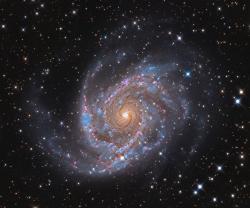
Howdy, Stranger!
It looks like you're new here. If you want to get involved, click one of these buttons!
BlockHead
About
- Username
- BlockHead
- Joined
- Visits
- 257
- Last Active
- Roles
- Member, Administrator
Comments
-
Hi Rod, I believe this video is now dated. Things change quickly. The new version of WBPP manual information is mostly encapsulated by the release information. PI developers are trying to put together more reference information (a new developer was …
-
Regarding the unlinked STF- the autoSTF can be applied to the brightness of the image (that is all three colors at the same time) or it can do an autoSTF on EACH color independently (the unlinked version). Here are the important points from FastTrac…
-
Hi Matt, Weird things in...weird things out. The darks really do need to be at the same time- or there will be issues (which may or may not be part of your problem). The solid colored background is perfectly fine for a non-color corrected image. (P…
-
Hi Jeff, I am considering this- though I am not certain how much I would be able to add to the TAIC presentation. Here is the thing- when I was asked to create videos for Pixinsight I began by learning the software and attempting to reach a level…
-
I have a lot of videos don't I?To answer your question there are two things. Rejection High only expands things that are detected/rejected in the data. So if the trail (or anything else) is not captured by the mathematical rejection- nothing more wi…
-
Hi Donald, This is always a hard question to answer- but you need to satisfy a few things: 1. You need to collect enough frames to get good statistics in order to process the data in terms of weighting, normalization and most especially rejection. T…
-
Good job!Yes, indeed, in a number of videos I stress that optimization of darks does not always work and the image processor (you) needs to be vigilant for issues. Sincerely,-the Blockhead
-
Hmm... I am glad things are working... but not happy to not know why.We would have to look at the output of the (intermediate) files that lead up to the integrated result. The answer is there- but you probably do not have files anymore... Thanks fo…
-
I do not think you need to re-do anything. I literally put the data into to WBPP (your same data) and pressed the button. So, there is a configuration issue. You might need to tell me what the entire set up you programmed. I have a sneaking suspici…
-
Hi Donald, I downloaded your data and ran it through WBPP. The attached screenshot is the master light frame (not color corrected) result. I see no evidence of the walking noise. I cannot explain your initial result. I do have a suggestion though.…
-
This last image is from the same data set I assume.So please make the data available.-the Blockhead
-
Hi Donald, As I am sure you have been told- this is walking noise due to the fact the data is not dithered. (Dithering your telescope when acquiring the images will be a big big help to solve this without haven't to worry about difficult processing …
-
Yes.. you have it now... everything is good.-the Blockhead
-
Jordi, This isn't a problem though, it is normal when registering images. It IS a problem if the images are not being properly registered. -the Blockhead
-
I should add, if your images *were* very closely aligned..and then after registration became mis-aligned...this is truly a registration issue. Sometimes the distortion correction finds a solution that isn't valid.-the Blockhead
-
Hi Jordi, This is an outcome of aligning (registering using StarAlignment) your images. One image is your reference frame and all other images are aligned to it. Your images are shifted (due to dithering, pointing or other things) so the regions whe…
-
Correct...in general I am not posting the same content to YouTube that I create for AdamBlockStudios. I did in the case of WBPP.-the BLockhead
